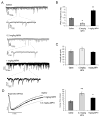A Clinically-Relevant Dose of Methylphenidate Enhances Synaptic Inhibition in the Juvenile Rat Prefrontal Cortex
- PMID: 30221243
- PMCID: PMC6136665
- DOI: 10.17756/jrdsas.2016-030
A Clinically-Relevant Dose of Methylphenidate Enhances Synaptic Inhibition in the Juvenile Rat Prefrontal Cortex
Abstract
Methylphenidate (MPH) is perhaps the most commonly prescribed psychoactive substance for young children and adolescents; however, its effects on the immature brain are not well understood. MPH is increasingly abused by adolescents and prescriptions are being issued to increasingly younger children without rigorous psychological testing, raising the potential for misdiagnosis; it is therefore crucial to understand how this drug might impact a healthy, developing brain. Recently, we have shown that a clinically-relevant dose of MPH depresses the activity of pyramidal neurons in the prefrontal cortex of normal juvenile rats, but its effects on inhibitory synaptic transmission remain to be explored. We therefore recorded spontaneous (s), miniature (m), and evoked (e) inhibitory postsynaptic currents (IPSCs) in layer 5 pyramidal neurons in juvenile rat prefrontal cortex. We found a dose-dependent effect of MPH on sIPSC frequency but not amplitude, where 0.3 mg/kg significantly decreased frequency, but 1 mg/kg significantly increased frequency. Moreover, mIPSCs were not affected by either dose of MPH, whereas the amplitudes, as well as paired-pulse ratios and coefficient of variations of evoked IPSCs were significantly increased after MPH treatment, indicating a presynaptic action. Tonic GABA current was also not affected by MPH treatment. Taken together, these results suggest that MPH administration to a healthy juvenile may enhance excitation of GABAergic interneurons; thus shifting the excitation-inhibition balance in the prefrontal cortex towards inhibition, and depressing overall prefrontal cortical activity. Our findings also indicate that the adolescent brain is more sensitive to MPH than previously thought, and dose ranges need to be reconsidered for age as well as size.
Keywords: ADHD; GABA; Interneuron; Juvenile; Prefrontal cortex; Psychostimulant.
Conflict of interest statement
Conflict of Interest The authors claim no financial conflict of interests.
Figures




Similar articles
-
Treatment with a clinically-relevant dose of methylphenidate alters NMDA receptor composition and synaptic plasticity in the juvenile rat prefrontal cortex.Neurobiol Learn Mem. 2013 Mar;101:65-74. doi: 10.1016/j.nlm.2013.01.004. Epub 2013 Jan 18. Neurobiol Learn Mem. 2013. PMID: 23333502 Free PMC article.
-
Distinct age-dependent effects of methylphenidate on developing and adult prefrontal neurons.Biol Psychiatry. 2012 Nov 15;72(10):880-8. doi: 10.1016/j.biopsych.2012.04.018. Epub 2012 May 19. Biol Psychiatry. 2012. PMID: 22609367 Free PMC article.
-
Clenbuterol reduces GABAergic transmission in prefrontal cortex layer 5/6 pyramidal neurons of juvenile rat via reducing action potentials firing frequency of GABAergic interneurons.J Neurochem. 2018 Jan;144(2):152-161. doi: 10.1111/jnc.14248. Epub 2017 Dec 6. J Neurochem. 2018. PMID: 29086421
-
[Effect of methylphenidate on c-Fos expression in parvalbumin interneurons of juvenile rat frontal cortex].Sheng Li Xue Bao. 2017 Aug 25;69(4):378-384. Sheng Li Xue Bao. 2017. PMID: 28825095 Chinese.
-
Methylphenidate enhances inhibitory synaptic transmission by increasing the content of norepinephrine in the locus coeruleus of juvenile rats.Kurume Med J. 2010;57(1-2):29-38. doi: 10.2739/kurumemedj.57.29. Kurume Med J. 2010. PMID: 21727763
References
-
- Polanczyk G, de Lima MS, Horta BL, Biederman J, Rohde LA. The worldwide prevalence of ADHD: a systematic review and metaregression analysis. Am J Psychiatry. 2007;164(6):942–948. - PubMed
-
- Insel TR. Post by Former NIMH Director Thomas Insel: Are Children Overmedicated? National Institutes of Mental Health; Washington, D.C., USA: 2014.
Grants and funding
LinkOut - more resources
Full Text Sources
Other Literature Sources
